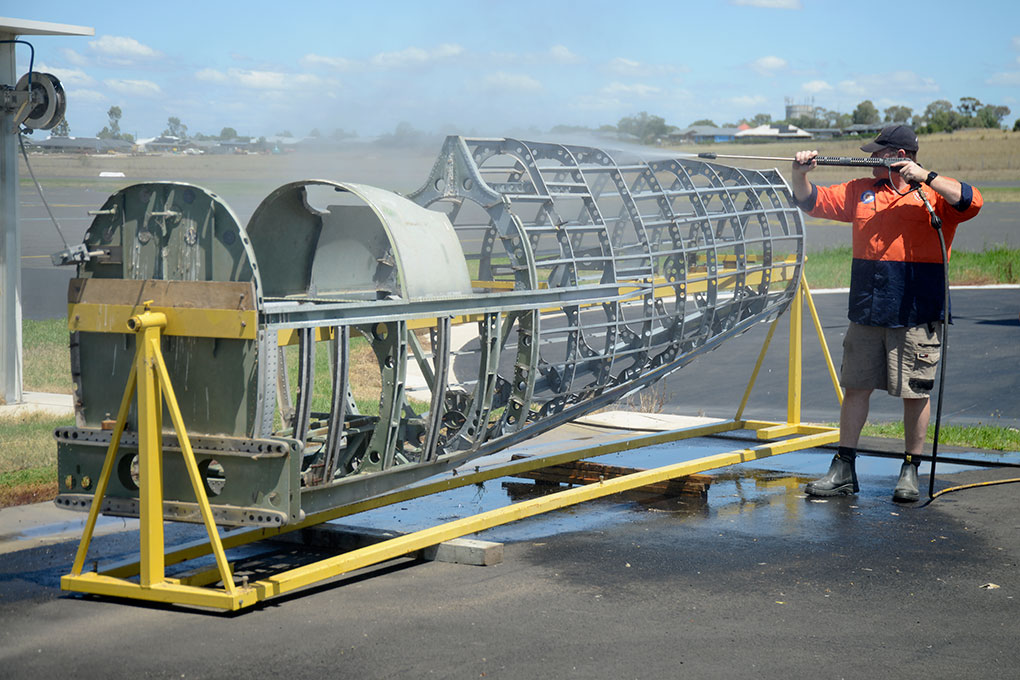
Cooma flying ace F/Lt Pat Hughes’ Supermarine Spitfire is to be restored by the Hunter Fighter Collection Inc. in Scone. Photo: Hunter Fighter Collection Inc.
As a town with a proud military history, Cooma has yet another reason to celebrate the achievements of one of its own.
Cooma was the birthplace of World War II flying ace, Pat Hughes, who was born there on 19 September, 1917.
In his too-short life, Pat filled his hours with achievements and bravery.
Flying for the Royal Air Force during the Battle of Britain, his Spitfire crashed shortly after Pat recorded his 17th kill, a Dornier 17, over Kent, on 7 September, 1940. Pat bailed out of his plane, but his parachute did not open. His body was found in a garden in Sundridge, Kent.
His plane crashed soon afterwards at Darks Farm, near Bessels Green, Kent.
He was posthumously awarded the Distinguished Flying Cross (DFC) on 22 October, 1940, an honour accepted by his wife Kay at Buckingham Palace on 23 June, 1942. The couple had only been married for five weeks when Pat died.
Pat was the top-scoring Australian flying ace of the Battle of Britain and one of 13 Australian fighter pilots killed (another was lost as a PoW) during the battle.
Pat has been described as “the inspiration and driving force behind No. 234 Squadron RAF”. He is generally credited with 17 confirmed victories — 14 solo and three shared. This tally puts him among the top 10 Allied Battle of Britain aces.
It also ranks him among the three highest-scoring Australians of World War II, after Clive Caldwell with 30 victories (27 solo and three shared) and Adrian Goldsmith with 17 (16 solo and one shared).
Pat was honoured with a memorial located in the Monaghan Hayes Place in Cooma, part of the war memorial precinct, in 2008.
Now, another honour is in progress for Pat.

Cooma flying ace opt Hughes’ Supermarine Spitfire is to be restored by the Hunter Fighter Collection Inc.in Some. Photo: Hunter Fighter Collection Inc.
Supermarine Spitfire MkIa X4009 was acquired as a project by Ross and Ann-Maree Pay and was generously donated to Hunter Fighter Collection Inc.
Work has begun on restoring his Spitfire and bringing it to Australia to be part of the Hunter Warbirds Museum in Scone.
The museum is dedicated to the collection, acquisition, restoration and display of historical and significant Australian built and operated aircraft.
The aircraft collection and related artefacts are acquired and restored on site by Hunter Fighter Collection volunteers.
The wrecked Spitfire is presently being packed into a container to be shipped to Australia where restoration work, likely costing millions of dollars, will continue.
Hunter Warbirds public officer, and museum curator, John Parker, said the group would basically be building a plane from scratch, using the Spitfire X4009 identity plates.
He said the group had received a $150,000 grant from the “Saluting Their Service” grants program, but that money had already been expended in Britain, readying the plane for departure.
The restoration is expected to take about five years, but the group is completing each of seven steps along the way.
A replica Spitfire fuselage is already being restored and a fundraising campaign is underway to finance the rest of the project.
Mr Parker said the work would be carried out by an experienced team which already had successfully completed restorations.
The museum boasts other Spitfires, a Mustang and a Vampire.
Donations to help complete her restoration will be gratefully appreciated. Go to www.hfcscone.org.au to help X4009 fly again.
A donation of $2 or more is tax deductible in Australia.







